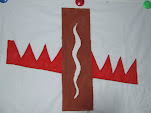© Eso Antons Benjamins
NOT-VIOLENT TERROR
35 Not-Violent Populism (VII)
Latvian history books present the Latvians as an ethnic group that regained its self-consciousness after centuries of sleep under neo-Christian (German and Russian variety) oppression and rose out of the sleep as a branch off the aboriginal Balts, a brother and sister nation to kindred Lithuania.
The most recent geopolitical loss of the Balts was the repression and absorption of the Baltic Prussians into the German state of Prussia, with Choninpils (imagined or real, who knows) forced to change its name to Koenigsberg and then to Kaliningrad. This loss effectively destroyed the Balts as a collective of political interest groups. The Baltic tribes that survived the land grab of their former territories by numerous European kings and princes joined with the Poles as Lithuanians. The Latvians, a people with a self-identification created in conditions of the forest, family-like clans (saimes) of occupant disrupted clans, knew the woods. They had never left them and continued to identify with them.
The course of history conspired in such a way, that many of these people of the sylvan forest and arch-Christendom survived. They began to emerge as a people in their own right about the middle of the 19th century by way of song. That is, they became aware of themselves through getting together for song festivals on land cleared of forest by need or order of occupant barrons and boyars building themselves fleets of ships to exploit others as well. With a populist self-awareness of themselves as a forest people (probably sometime after the French Revolution and the deposition of the sacred king), there came self-assertion, but over the recent generations little remembrance and interest of the past left behind.
The book to initiate Latvia as a cultural and geopolitical entity is “Lihgo”, 1874, a collection of the lyrics of popular songs. The lyrics were strategically interspersed with poems meant to build community consciousness and fire up feelings of loyalty to the land and the group that speak a more or less one and the same language. The book was published by the composer-artist-poet Karlis Baumanis. [Better known as Baumanu Kahrlis, he also composed the lyrics and melody of the Latvian national anthem, and was the first to use the word Latvia.] The tsar’s police confiscated and burnt almost all copies of the book. The artist chose for its cover his own drawing. The drawing is dated 1873. The illustration shows a priest on Jahnis Eve [the popular name of the midsummer’s Eve festivities still celebrated today] lighting a sacred fire. The altar is in a forest clearing with an oak tree blessing it with its cover. The priest identifies with the forest by holding in his right hand an oak leaf branch. The drawing is on the flag of the All Latvian Song Festival, celebrated in Latvia every five years since 1873. http://tinyurl.com/ygbqp8p
We note that the priest of Johns Eve is never named John, even if he is so named in the mind’s eye of the large group of people who stand behind the oak tree in an extension of the forest clearing in the foreground. Instead, the book is named “Lihgo”, and this word is printed over John officiating at the altar, suggesting that Lihgo=John. The association must be made in silence, because not only is John the priest of Jahnis Eve, he is also an ideal representation of Latvians as they imagined themselves at that time. They could not however name themselves. Tsar and a God somewhere in the sky were trying to replace the sylvan people’s arch-Christian John with neo-Christian Jesus, who came in the image of the Russian neo(orthodox) -Christian Church doing the tsar’s bidding. By 1888, the consequences of Enlightenment and the French Revolution had reached the ears of then emerging Latvian intelligentsia. With a cleverness characteristic of an intelligentsia, the leaders of the woods people became traders of lumber and carpenters. In turn, the lumber traders and carpenters—with an obsequiousness also so characteristic of the emerging formerly repressed (to better fit in with the occupiers)—replaced the priest of the arch-Christian Jahnis with Lachplehsis, Bearjawbraker. He was a man with a bear’s ears, who, while he resembled an aboriginal Balt (still in the woods), was a copy of Sampson tearing open the jaws of a lion in Luther’s Illustrated Bible. In essence, a Latvian was identified as a Lutheran, who most likely was further identified with all things German.
In the span from 1873 to 1940, the image in the inner self of a self-conscious Latvian became so sterilized and turned into décor by the bourgeois that when it came to offering one’s life on the community’s altar, Karlis Ulmanis was torn by doubts. These doubts were sourced in neo-Christianism, Soviet universalism, the sundering of Latvian society by economic stratification, and absence of the never mentioned tradition of self-sacrifice as the glue of societies and nations. Came 1940, Ulmanis didn’t do it. In 1993, Buchis sacrificed his life for the idea of an economically egalitarian sovereign (uncorrupt) Latvia. Buchis’s act received some attention, but it turned out to be short-lived media rhetoric.
The musical drama “Vadonis” does not mention the priest of Jahnis Eve, because the authors no longer know him. The Latvians limp on caught in a death warp, trailing the “halle-luia” sound, with the “luia” reminding very much of the once ecstatic Lihgo affirming life.
Please consider reading the previous blog. The ideas therein are possibly related to those presented here.
If you copy this blog for your own files, or to be forwarded, or its content is otherwise mentioned, please credit the author and http://esoschronicles.blogspot.com/
Subscribe to:
Post Comments (Atom)

No comments:
Post a Comment